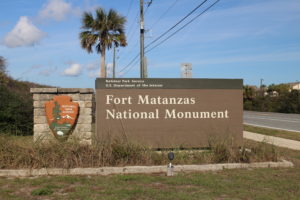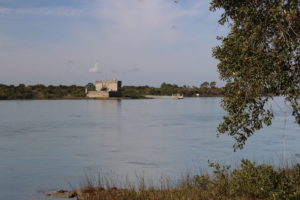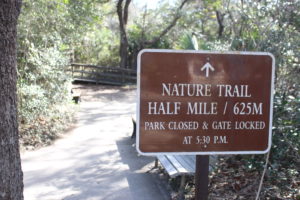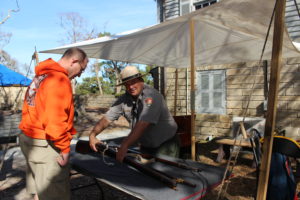 After the Spanish established St. Augustine and Castille de San Marcos, the Spanish realized that the town was vulnerable to attack from the Matanzas Inlet to the south. Enemy ships could attack the town from the rear, out of range of the Castillo’s cannon. General James Oglethorpe blockaded St. Augustine inlet in 1740 for 39 days. The fort might have been captured if a similar blockade had taken place from the south.
After the Spanish established St. Augustine and Castille de San Marcos, the Spanish realized that the town was vulnerable to attack from the Matanzas Inlet to the south. Enemy ships could attack the town from the rear, out of range of the Castillo’s cannon. General James Oglethorpe blockaded St. Augustine inlet in 1740 for 39 days. The fort might have been captured if a similar blockade had taken place from the south.
To prevent the British from attacking from the rear, carpenters, masons, and soldiers began building Fort Matanzas. They completed the fort just in time. In 1742, Oglethorpe arrived at the inlet with 12 ships. When the fort’s cannon drove off his scouting boats, Fort Matanzas passed its test.
 From 1763 to 1784 the British had control of Florida but felt little need to maintain the fort because they occupied Castillo de San Marcos. When the Spanish regained Florida in 1784, they also let the fort deteriorate. The United States took possession of Florida and Fort Matanzas in 1821 but never occupied the fort.
From 1763 to 1784 the British had control of Florida but felt little need to maintain the fort because they occupied Castillo de San Marcos. When the Spanish regained Florida in 1784, they also let the fort deteriorate. The United States took possession of Florida and Fort Matanzas in 1821 but never occupied the fort.
But Fort Matanzas is best known for something that happened before the fort was built. In 1565, when the Spanish were trying to get rid of the French settlement at Fort Caroline, a group of 400 French soldiers sailed south, expecting to attack St. Augustine. A hurricane blew the ships far to the south and the ships wrecked near present-day Daytona Beach. One hundred thirty soldiers survived the shipwreck. They marched north, but they were starving and sick by the time they neared St. Augustine.
A small Spanish force, led by Admiral Pedro Menendez de Aviles, easily captured them. The Spanish killed all the French soldiers, except for 16 who professed to being Roman Catholic. Two weeks later, the Spanish captured and killed another 120 French soldiers. This is where Matanzas gets its name. In Spanish, “matanzas” means slaughter.
 Fort Matanzas became a National Monument in 1924 and part of the National Park Service in 1933. Congress allocated money to stabilize the fort and build docks for access.
Fort Matanzas became a National Monument in 1924 and part of the National Park Service in 1933. Congress allocated money to stabilize the fort and build docks for access.
Today the National Monument consists of 300 acres. There is a small Visitors Center and a passenger ferry to take visitors across the inlet to the Fort. Unfortunately the docks were badly damaged by Hurricane Matthew and the ferries will not run until the docks are replaced. There is beach access across the street from the Visitors Center but the hurricane also destroyed the boardwalks.
 Tom and I watched the short (and old) movie and went outside to talk to a Ranger. He was sitting behind a table where he laid out the items commonly used by Spanish soldiers during the battles with the French and with the British. He showed us replicas of three guns used over the years at Fort Matanzas. We talked with him for a while, walked the short nature trail, and headed north.
Tom and I watched the short (and old) movie and went outside to talk to a Ranger. He was sitting behind a table where he laid out the items commonly used by Spanish soldiers during the battles with the French and with the British. He showed us replicas of three guns used over the years at Fort Matanzas. We talked with him for a while, walked the short nature trail, and headed north.
Fort Matanzas is not a big tourist attraction like Castille de San Marcos, but it is definitely worth visiting if you are interested in the history of colonial settlement.
